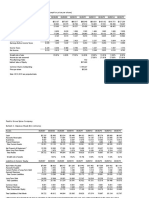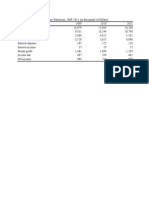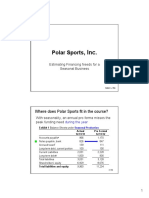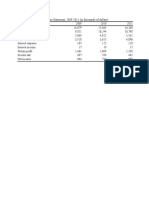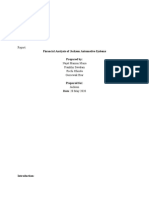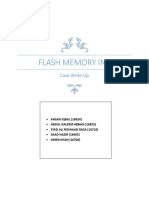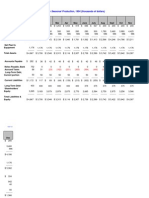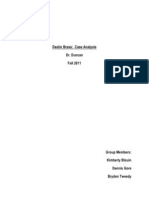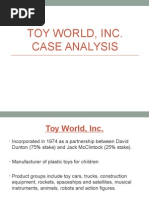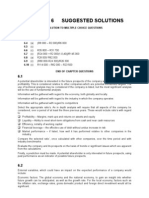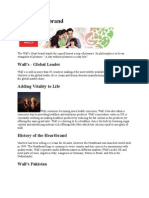Polar Sports, Inc
Polar Sports, Inc
Uploaded by
Jennifer JacksonCopyright:
Available Formats
Polar Sports, Inc
Polar Sports, Inc
Uploaded by
Jennifer JacksonOriginal Description:
Copyright
Available Formats
Share this document
Did you find this document useful?
Is this content inappropriate?
Copyright:
Available Formats
Polar Sports, Inc
Polar Sports, Inc
Uploaded by
Jennifer JacksonCopyright:
Available Formats
Dr.
Ujjwal Mishra
Prof. A. C. Panda
Polar Sports, Inc
1. Overview/Facts
Polar sports, Inc. is into fashion skiwear
manufacturing business, which is seasonal and
very short product life.
As the products are seasonal the company
follows seasonal production scheduling method.
Now the company wants to shifts to level
production method, which will reduce the cost but
uncertain about the impact on other aspects of
the busies (i.e. Risk, Liquidity & Financing)
2. Industry Overview
The Ski apparel business is a seasonal business,
it is highly competitive and very low product life.
North Face, Burton, Karbon, Spyder Active
Sports, Sports obermeyer, Parda and Giorgio are
the major player in the apparel market
As the Market is highly competitive, some players
have shifted their production to Asia and Latin
America.
Due to High competition in both designing and
pricing, there is a high rate of company failure
3. Problem Statement
Should the management consider to shift level
production method from seasonal scheduling
production Method
4.Objective
Understanding and interpretation of financial
statements (Income statement, Balance sheet &
Cash flow statement)
To analyze the profitability and liquidity aspects of
the firm.
To estimate the funds required for a change in
production method.
5. Alternative
To consider for Level production Method
To follow the Existing, Seasonal Production
scheduling Method
To consider both the methods
Criteria
Risk of profitability and Liquidity
Source of Sort term financing and risk
Analysis (as per original case
exhibits)
Seasonal Production Level Production
Pros:
a) Requires minimum short term
financing
b) Less risk
c) Less inventory holding
Pros:
a) Reduces operating cost
Cons:
a) Increases operating Cost
Cons:
a) Requires more short term financing
b) High risk
c) High Inventory Holding.
Analysis
Net Savings From Level Production
Overtime wage premiums 480,000
Other direct labor savings 600,000
Net savings before financial charges, carrying costs,
inventory losses, and taxes 1,080,000
Increase in interest expenses 147,923
Reduction in interest income 16,140
Increase in storage cost 300,000
Net pretax savings 615,937
Less tax at 34% 209,418
Net savings 406,518
7. Suggestion
From the above analysis, it shows that the
company can save around $ 406,518 if the
company follows Level production method, instead of
Seasonal Production Method.
Hence the company should follow the level production
Method
Key Take away
Analysis of Financial statements
Divergence in Accounting Income and cash flow
Questions for Discussion
What factors must be considered by Mr. Weir for
deciding, whether to adopt Level production?
Solution:
1. Net saving from level production $406518 /-
2. The difference in profit between two production Plans $
1553141 /- under Level Production & 1146623 under
Seasonal Production.
3. Level production reduces COGS from 66 % to 60 %
Find out the total savings, if Level production is
adopted
Solution:
Total Savings From Level Production
1. Overtime wage premiums 480,000
2. Other direct labor savings 600,000
3. Total savings before financial charges, carrying
costs, inventory losses, and taxes 1,080,000
Does increased net income justifies the potential
risk that may arise due to increase in risk
Solution:
Yes, The net Income Justifies the Potential risk,
which is arising from the peak Inventory level of $
6,483,000 in the month of August.
Financing Risk: Bank
Can the company able to finance its production
activity
Solution:
1. Yes Mr. Weir has to convince the Bank regarding companies
financial strength, as it absorbs substantial inventory losses
and still repay the bank in Jan next year.
2. Substitute of Bank credit is Polar could ask its trade suppliers
for terms longer than 30 days, i.e. 90 days credit term
Purchases which will help the company to generate around
90000
You might also like
- Investment Analysis - Polar Sports (A)Document9 pagesInvestment Analysis - Polar Sports (A)pratyush parmar100% (13)
- Polar Sports, Inc SpreadsheetDocument19 pagesPolar Sports, Inc Spreadsheetjordanstack100% (3)
- Toy World, Inc. Case SolutionDocument23 pagesToy World, Inc. Case SolutionArjun Jayaprakash Thirukonda80% (5)
- Jones Electrical Distribution Case ExhibitsDocument7 pagesJones Electrical Distribution Case ExhibitsJustin Ho100% (1)
- Play Time Toys. Supplement 1 (To Do) Pro Forma Income Statements Under Level Production (1991)Document12 pagesPlay Time Toys. Supplement 1 (To Do) Pro Forma Income Statements Under Level Production (1991)cpsharma150% (1)
- Pacific Grove Spice Company SpreadsheetDocument7 pagesPacific Grove Spice Company SpreadsheetAnonymous 8ooQmMoNs10% (1)
- Caso Jackson Automotive SystemDocument7 pagesCaso Jackson Automotive SystemDiego E. Rodríguez100% (2)
- Harvard Case Study - Flash Inc - AllDocument40 pagesHarvard Case Study - Flash Inc - All竹本口木子100% (1)
- New Heritage Doll Company Case SolutionDocument31 pagesNew Heritage Doll Company Case SolutionSoundarya AbiramiNo ratings yet
- Hanson Case AnalysisDocument3 pagesHanson Case AnalysisMonika100% (1)
- Polar Sports Inc.Document4 pagesPolar Sports Inc.Talia100% (1)
- Jackson Automotive Systems ExcelDocument5 pagesJackson Automotive Systems Excelonyechi2004No ratings yet
- Flash Memory, IncDocument16 pagesFlash Memory, Inckiller drama67% (3)
- Sampa Video Solution Harvard Case SolutionDocument11 pagesSampa Video Solution Harvard Case Solutionhernandezc_jose100% (1)
- Flash Memory Case SolutionDocument10 pagesFlash Memory Case SolutionsahilkuNo ratings yet
- Joint Cost SignatronDocument8 pagesJoint Cost SignatronGloryNo ratings yet
- Jackson AutomotiveDocument3 pagesJackson AutomotiveErika Theng25% (4)
- SureCut Exhibits and QuestionsDocument16 pagesSureCut Exhibits and Questionssergej0% (1)
- (Holy Balance Sheet) Jones Electrical DistributionDocument29 pages(Holy Balance Sheet) Jones Electrical DistributionVera Lúcia Batista Santos100% (1)
- Operations Management Toffee IncDocument12 pagesOperations Management Toffee IncRonak PataliaNo ratings yet
- Polar SportsDocument7 pagesPolar SportsShah HussainNo ratings yet
- Polar SportsDocument15 pagesPolar SportsjordanstackNo ratings yet
- Case - Polar SportsDocument12 pagesCase - Polar SportsSagar SrivastavaNo ratings yet
- Flash Memory IncDocument7 pagesFlash Memory IncAbhinandan SinghNo ratings yet
- Tire City Spreadsheet SolutionDocument6 pagesTire City Spreadsheet Solutionalmasy99100% (1)
- Tire City AnalysisDocument1 pageTire City AnalysisNikhil Kangutkar80% (10)
- Pacific Grove Spice CompanyDocument3 pagesPacific Grove Spice CompanyLaura JavelaNo ratings yet
- Assignment #2 Workgroup E IttnerDocument8 pagesAssignment #2 Workgroup E IttnerAziz Abi AadNo ratings yet
- Stone Container CorporationDocument11 pagesStone Container CorporationMeena100% (3)
- Flash Memory AnalysisDocument25 pagesFlash Memory AnalysisTheicon420No ratings yet
- Lady MDocument2 pagesLady MMəhəmməd Əli HəzizadəNo ratings yet
- FlashMemory Beta NPVDocument7 pagesFlashMemory Beta NPVShubham Bhatia50% (2)
- SLIDE PPT Pearson Working CapitalDocument58 pagesSLIDE PPT Pearson Working Capitaldheo pratamaNo ratings yet
- Case Memo InstructionsDocument4 pagesCase Memo InstructionsVish KamdarNo ratings yet
- PolarSports Solution PDFDocument8 pagesPolarSports Solution PDFaotorres99No ratings yet
- Polar Sports: Where Does Polar Sports Fit in The Course?Document21 pagesPolar Sports: Where Does Polar Sports Fit in The Course?Hugo100% (1)
- Polar Sports, Inc - AnalysisDocument15 pagesPolar Sports, Inc - Analysisjordanstack0% (1)
- Polar SportDocument4 pagesPolar SportKinnary Kinnu0% (2)
- Table A Consolidated Income Statement, 2009-2011 (In Thousands of Dollars)Document30 pagesTable A Consolidated Income Statement, 2009-2011 (In Thousands of Dollars)rooptejaNo ratings yet
- Investment Analysis Polar Sports ADocument9 pagesInvestment Analysis Polar Sports AtalabreNo ratings yet
- Polar SportsDocument9 pagesPolar SportsAbhishek RawatNo ratings yet
- Jackson Auto Motives ReportDocument12 pagesJackson Auto Motives ReportNajat Muna100% (1)
- Polar Sports X Ls StudentDocument9 pagesPolar Sports X Ls StudentBilal Ahmed Shaikh0% (1)
- Flash Memory IncDocument3 pagesFlash Memory IncAhsan IqbalNo ratings yet
- Toy World CaseDocument9 pagesToy World Casedwchief100% (1)
- Tire City Inc.Document6 pagesTire City Inc.Samta Singh YadavNo ratings yet
- Tire City IncDocument12 pagesTire City Incdownloadsking100% (1)
- Destin Brass FinalDocument10 pagesDestin Brass FinalKim Garver100% (2)
- 03 Gilbert Lumber CompanyDocument36 pages03 Gilbert Lumber CompanyEkta Derwal PGP 2022-24 BatchNo ratings yet
- Tire City Spreadsheet SolutionDocument8 pagesTire City Spreadsheet SolutionsuwimolJNo ratings yet
- Case Analysis - Toy WorldDocument11 pagesCase Analysis - Toy Worldvarjin71% (7)
- Flash Memory, Inc.Document2 pagesFlash Memory, Inc.Stella Zukhbaia0% (5)
- Linear TechnologyDocument4 pagesLinear TechnologySatyajeet Sahoo100% (2)
- Group 1Document16 pagesGroup 1Mariann Jane GanNo ratings yet
- Ros69749 ch19Document9 pagesRos69749 ch19arzoo26No ratings yet
- Polar Sports 5 PDFDocument18 pagesPolar Sports 5 PDFPaolo SergioNo ratings yet
- Assignment # 1 Corporate Finance Fall 2011Document6 pagesAssignment # 1 Corporate Finance Fall 2011Madiha BhuttaNo ratings yet
- Assignment Lecture 1Document5 pagesAssignment Lecture 1jaiminNo ratings yet
- Task 4 CompletedDocument13 pagesTask 4 CompletedTan ChongEe100% (1)
- 2020 Problem MojakoeDocument6 pages2020 Problem Mojakoedara ibthiaNo ratings yet
- 4.2 Capital InvestmentDocument22 pages4.2 Capital InvestmentIshaNo ratings yet
- Ufa#Ed 2#Sol#Chap 06Document18 pagesUfa#Ed 2#Sol#Chap 06api-3824657No ratings yet
- Week 4 TIN 403 Simulasi Sistem - Monte-Carlo SimulationDocument7 pagesWeek 4 TIN 403 Simulasi Sistem - Monte-Carlo SimulationPrinCe PerSieNo ratings yet
- International Business: by Charles W.L. HillDocument31 pagesInternational Business: by Charles W.L. Hillra000089No ratings yet
- Depreciation MCQDocument3 pagesDepreciation MCQWalid Mohamed AnwarNo ratings yet
- Soln 1 RDocument2 pagesSoln 1 RLooRee BerrBerrNo ratings yet
- December 12, 2014Document20 pagesDecember 12, 2014Anonymous KMKk9Msn5No ratings yet
- CMA DATA Format BlankDocument16 pagesCMA DATA Format BlankRaghavendra Kulkarni40% (5)
- Mechanised Laying of Track On Construction ProjectDocument26 pagesMechanised Laying of Track On Construction ProjectShuja MehdiNo ratings yet
- State Level Public Enterprises (PRC)Document3 pagesState Level Public Enterprises (PRC)nithinNo ratings yet
- Business Cycle and Stabilisation PolicyDocument19 pagesBusiness Cycle and Stabilisation PolicyKrunal PatelNo ratings yet
- Dental Implants & Prosthetics Market (Implants, Crowns & Bridges, Dentures, Abutments) Current Trends, Opportunities & Global Forecasts To 2018Document8 pagesDental Implants & Prosthetics Market (Implants, Crowns & Bridges, Dentures, Abutments) Current Trends, Opportunities & Global Forecasts To 2018KevalChauhanNo ratings yet
- Gillette GuardDocument4 pagesGillette GuardSushil GhadgeNo ratings yet
- Nepal Department of Roads 2007 Sector Wide ReportDocument162 pagesNepal Department of Roads 2007 Sector Wide ReportbeazolaNo ratings yet
- Capital Budgeting 5Document9 pagesCapital Budgeting 5Sarvesh SharmaNo ratings yet
- Emirates vs. BADocument6 pagesEmirates vs. BAaleroh90No ratings yet
- November 12 SK TC AGENDA PDFDocument24 pagesNovember 12 SK TC AGENDA PDFCovGansettSKPatchNo ratings yet
- India DistributionDocument19 pagesIndia DistributionRoshani JoshiNo ratings yet
- Income StatementDocument8 pagesIncome StatementDanDavidLapizNo ratings yet
- Debt Service Coverage RatioDocument7 pagesDebt Service Coverage RatioAamir BilalNo ratings yet
- 4-4 Minutes - Special MeetingDocument2 pages4-4 Minutes - Special MeetingDaniel100% (32)
- MCQ (New Topics-Special Laws) - PartDocument2 pagesMCQ (New Topics-Special Laws) - PartJEP Walwal100% (1)
- WallsDocument18 pagesWallssaimkhaNo ratings yet
- DL PT1Q F3 201301Document14 pagesDL PT1Q F3 201301MpuTitasNo ratings yet
- V. Marketing Aspect 5.1 Market DescriptionDocument11 pagesV. Marketing Aspect 5.1 Market DescriptionMarc Harald SteffenNo ratings yet
- Matrix On Shipping Lines ChargesDocument7 pagesMatrix On Shipping Lines ChargesPortCallsNo ratings yet
- P1 November 2014 Question PaperDocument20 pagesP1 November 2014 Question PaperMdNo ratings yet
- Sap Cin-MM Customizing For Tax Procedure - Taxinn: Hide TOCDocument7 pagesSap Cin-MM Customizing For Tax Procedure - Taxinn: Hide TOCsreekumarNo ratings yet
- Text Box: Paris - The Fashion Capital of The WorldDocument25 pagesText Box: Paris - The Fashion Capital of The Worldgangotri_kataNo ratings yet
- WeddingDocument27 pagesWeddingAkbar BhahestyNo ratings yet





